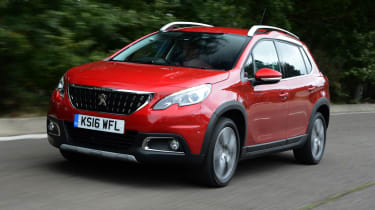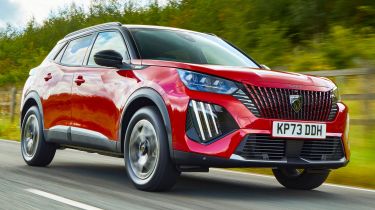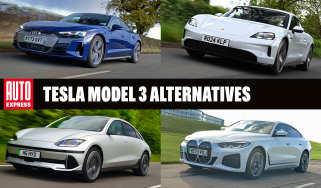Peugeot 2008 review
The Peugeot 2008 is fashionable and well-built, but it feels a little pricey compared to some close rivals

Is the Peugeot 2008 a good car?
The Peugeot 2008 stands out in the hotly contested compact crossover and small SUV segment, thanks in no small part to extravagant styling that’s been made even bolder after a facelift. Its eye-catching looks are backed up by a well-built cabin, a decent amount of boot space, and surprisingly refined motorway manners.
Frankly, you could do much worse than the 2008 when choosing from the smorgasbord of small SUVs on offer today. However, some rivals are more fun to drive, while others are more practical. The 2008 is priced against premium competitors, which could be a further sticking point for customers seeking value. It also features Peugeot’s divisive i-Cockpit cabin design, which doesn’t suit everyone.
|
Key specs | |
|
Fuel type |
Petrol, Mild-hybrid, Electric |
|
Body style |
Small SUV |
|
Powertrain |
1.2-litre, 3cyl, turbo, petrol, front-wheel drive |
|
Safety |
4-star EuroNCAP (2019) |
|
Warranty |
3yrs/60,000 miles |
How much does the Peugeot 2008 cost?
The Peugeot 2008 is the French firm’s supermini-sized SUV, and starts from £28,500, rising to £31,000 for the hybrid, and £34,500 for the electric model.
The second generation 2008 arrived to great acclaim in 2019. In the years that followed, the 2008 became one of Peugeot’s best-selling cars, even topping the list of Europe's best-selling crossovers in 2021, before being given a facelift in 2023 that included a new front end incorporating Peugeot's refreshed company logo and latest three-bar lighting signature.
The 2008 is based on the Stellantis group’s CMP small-car platform, which also serves as the base for the Peugeot 208 supermini, along with the Citroën C4 and Citroën C4 X, DS 3, Jeep Avenger, Vauxhall Corsa and Vauxhall Mokka.
More reviews
Car group tests
In-depth reviews
Long-term tests
Road tests
- New Peugeot 2008 facelift 2024 review: petrol power suits the updated small SUV
- New Peugeot E-2008 2023 facelift review
- New Peugeot e-2008 2022 review
Used car tests
The 2008’s engine range isn’t as extensive as some of its rivals, as buyers have a choice of either a 1.2-litre PureTech petrol engine with or without a hybrid system, or the pure-electric Peugeot E-2008. The entry-level 128bhp petrol engine in the 2008 will cover most needs, and it is paired with either a manual gearbox in Allure trim, or an eight-speed automatic with the top-spec GT. Meanwhile, the electric E-2008 offers an official range of 250 miles, and a smoother driving experience than any of the petrol-powered models. If you can’t afford the jump in price between the petrol and electric versions, the hybrid offers lower fuel costs for a smaller financial outlay.
Both petrol and all-electric models are available across the Allure and GT trim levels. All models have a 10-inch touchscreen with wireless Apple CarPlay and Android Auto smartphone connectivity, DAB radio, front and rear parking sensors, climate control, and 17-inch alloy wheels. Top-of-the-range GT trim adds a wireless phone charging pad, keyless entry and go, full LED headlights, a reversing camera, and ambient interior lighting.
Engines, performance & drive
The Peugeot 2008 still offers the choice of manual and automatic gearboxes, and a few different engine options, from a surprisingly tractable 128bhp 1.2 petrol, to a mild-hybrid with a short electric range, and two versions of all-electric with respectable performance. No version of 2008 is as sharp to drive as the Ford Puma, nor does it ride as comfortably as the Renault Captur. Read more about the Peugeot 2008's engines, performance and drive…
MPG, emissions & running costs
Petrol and hybrid versions of 2008 offer good fuel economy and emissions, while the electric E-2008 has a competitive EV range and relatively fast charging speeds compared with its rivals. Hybrid and electric models will appeal most to company car drivers looking to reduce their tax bills. Insurance will likely be pricier than other small SUVs, and the electric E-2008 depreciates heavily. Read more about the Peugeot 2008's MPG, emissions and running costs…
Interior, design & technology
The 2008 has a distinctive look both outside and inside, plus the interior has a premium feel that raises it above most small SUVs. It’s a shame that the most frequently used functions are all controlled through the central touchscreen, which makes it trickier to adjust things on the move compared with the physical controls found in the Volkswagen T-Cross. Still, the screen in all versions of 2008 is sizeable and comes with full wireless smartphone connectivity. Read more about the Peugeot 2008's interior, design and technology…
Boot space, comfort & practicality
The 2008 has plenty of space up front and a number of useful spots to store smaller items. The i-Cockpit layout might not suit all sizes of driver, so try before you buy. It isn’t that spacious in the back for adults, and a small door opening might be restrictive for parents putting children in car seats. Boot space is decent, but a Hyundai Kona offers more space, and the Ford Puma has its handy Megabox for additional underfloor storage. Read more about the Peugeot 2008's boot space, comfort, and practicality…
Reliability & safety
Peugeot as a brand has been scoring well in the most recent Driver Power customer satisfaction survey, with the 2008 beating key rivals such as the Nissan Juke and Vauxhall Mokka in the overall scores. It is a shame that the 2008 misses out on receiving the maximum five star rating from safety experts Euro NCAP when many of its rivals achieve a higher score. Read more about the Peugeot 2008s reliability and safety…
Peugeot 2008 alternatives
The Peugeot 2008 will appeal to those looking for a smart-looking and premium-feeling small SUV that is well-equipped and has a wide range of engine options. The addition of a mild-hybrid version helps provide a more fuel-efficient choice to challenge the full hybrid Honda HR-V, Hyundai Kona, and Toyota Yaris Cross – although the latter is more efficient than the 2008.
There’s also an all-electric model to take on the Hyundai Kona Electric, which will suit company car drivers hoping to keep their tax bills low, and it offers respectable electric range and relatively rapid charging speeds. However, the E-2008 is beaten overall range by our preferred 65kWh version of Kona Electric.
The quirky i-Cockpit interior layout of the 2008 won’t suit everyone, and it’s quite small in the back, which might lead parents towards the more spacious Kona or versatile Renault Captur. It also isn’t particularly fun to drive, so those coming at this from a regular supermini may want to look at the sharper-handling Ford Puma instead. Those looking for value will be better off with the Dacia Duster, while the Skoda Kamiq is a great all-rounder.
Used and nearly new
The Peugeot 2008’s timeline starts in 2013, around a year after the Peugeot 208 supermini it’s closely related to first went on sale. Across both generations of Peugeot 2008, the car has offered a blend of sharp styling, agile handling and a comfortable ride. The Peugeot 2008 Mk2 saw the small SUV move further upmarket than its predecessor, which, while giving the car a more premium feel, also made it a pricier buy.
Peugeot 2008 history

Peugeot 2008 Mk2: 2019-present
The second-generation Peugeot 2008 Mk2 built upon the foundations of its predecessor: practicality and interior build quality were improved, and the looks were more striking this time around. Like the Mk1 model, the Peugeot 2008 Mk2 had close ties to the Peugeot 208, so the two cars featured similar interior tech and features. The powertrain options were similar, too, consisting of petrol and diesel engines (the latter disappeared in 2022 due to poor sales) and – for the first time in a Peugeot 2008 – a pure-electric option.

Peugeot 2008 Mk1: 2013-2019
The Peugeot 2008 Mk1 went on sale in 2013 and was billed as the higher-riding equivalent of the Peugeot 208. While the two cars share many parts, the 2008 Mk1 is bigger and more spacious than the 208, and comes with more equipment as standard. Engine options consist of various petrol and diesel engines, and all Peugeot 2008 Mk1s are front-wheel drive. Read our full Mk1 Peugeot 2008 buyer’s guide here…
Peugeot E-2008 long-term test
Our deputy editor, Richard Ingram, was mostly pleased with the Peugeot E-2008’s performance as an efficient runaround, but he couldn’t help but feel that the overall space was rather limited for family duties. The Peugeot’s average real-world efficiency of 4.0mi/kWh is respectable enough for a car of this size, but the lack of any range readout on the dashboard was a consistent cause of frustration. You can read the full long-term test here...
Frequently Asked Questions
The Peugeot 2008 has an eye-catching look, a fine interior and decent amount of tech onboard for the money, plus its PureTech petrol engine is pretty frugal. It’s not quite as roomy in the rear seats as the spacious Skoda Kamiq, however, nor is it very fun to drive.










